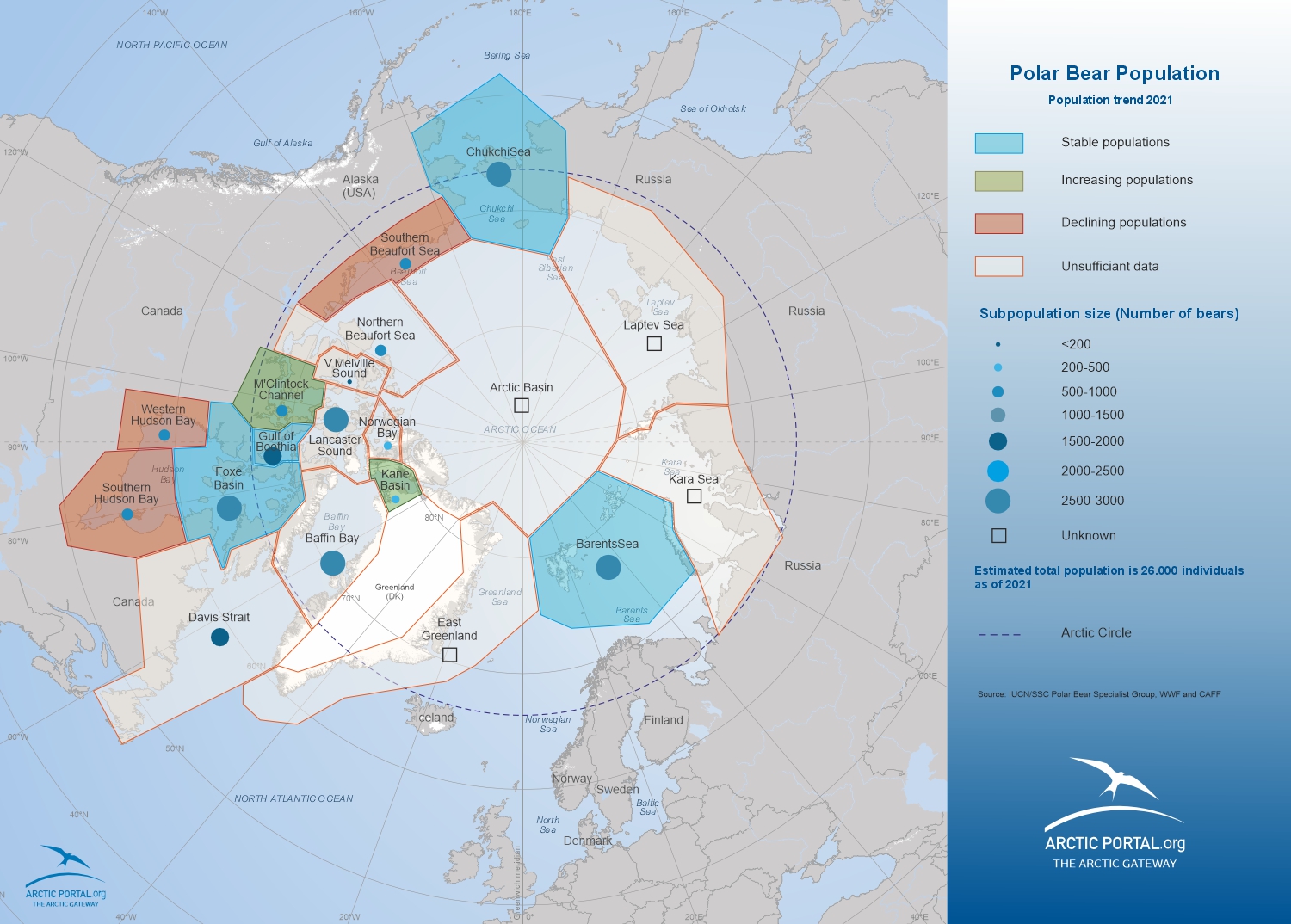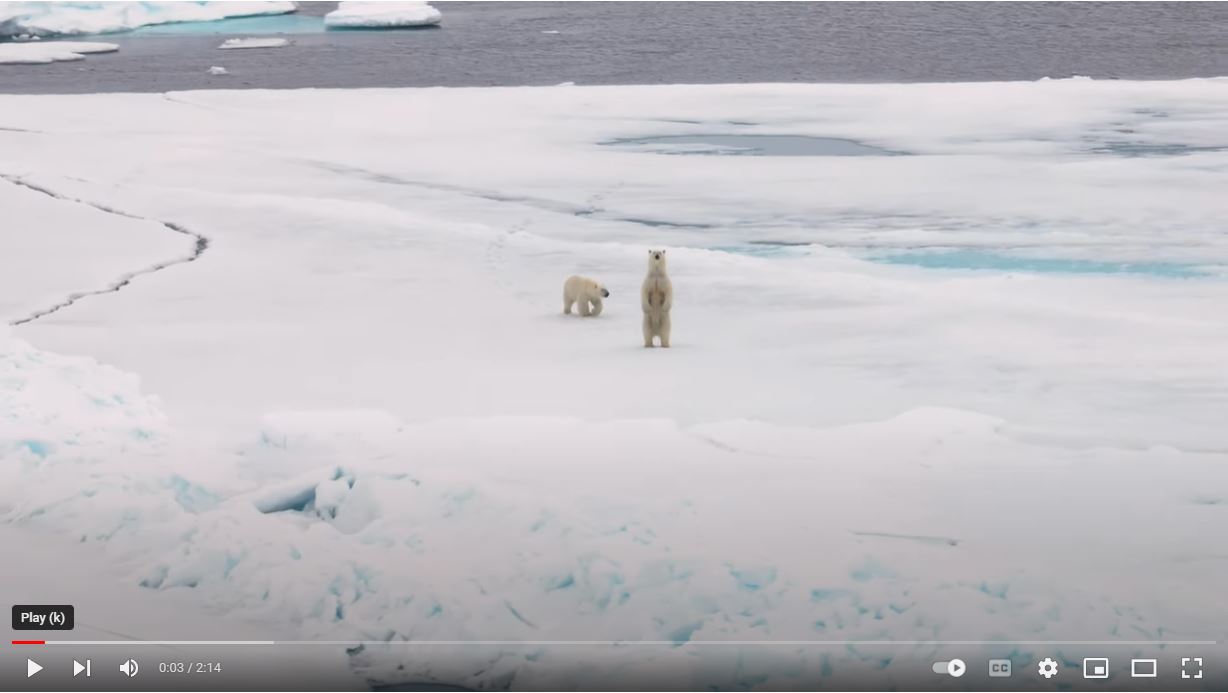The polar bear (Ursus maritimus) is the world’s largest land-going predator. It lives in coastal areas and on sea ice throughout the Arctic region. Polar bears live in 19 populations across the Arctic in Canada (estimated about 60%), U.S. (Alaska), Russia, Greenland, and Norway (Svalbard) with an estimated total population of 26.000 individuals as of 2021.
Most of the population areas are extremely remote and therefore it is very difficult and expensive to study the population of Polar Bears comprehensively due to their remoteness, long distances and lack of infrastructure. Monitoring both short-term and long-term is thus a challenge and is the reason why large population areas are currently defined as data deficient.
Although better information is now available for several subpopulations, scientists do not have clear figures on the total number of polar bears worldwide or the short-term population fluctuations as some estimates remain missing, outdated, or include large uncertainty. The map shows the areas of polar bear population in the Arctic and the estimated current population trends as reported by WWF and CAFF.
The most recent estimate of global abundance is 26,000 (95% Confidence Interval [CI] = 22,000–31,000; Regehr et al. 2016). Like previous ranges, these numbers must be interpreted with caution because they reflect the status of polar bears as well as the amount and quality of scientific information, both of which can change over time. Adjustments to the reported global estimate will continue as new information becomes available. (source: IUCN-pbsg.org PBSG Status Criteria and Report July2021_FINAL_02Dec)
Polar Bear hunting was a threat to the population but has been greatly reduced or completely stopped. Now, Climate change with less sea ice and Arctic development are increasing threats and affecting the habitats and source of food for the Polar Bear. Due to lack of factual knowledge, it is a challenge to estimate accurately the circumpolar trend in the population and more research and monitoring is needed. It is estimated that in some areas the number of bears has gone up but the general consensus is that the number of polar bears worldwide is not increasing. Some populations are recovering after their numbers were vastly reduced by uncontrolled hunting in the 1960s, but that potential for growth is running headfirst into declining carrying capacity in some regions due to loss of sea ice habitat.
Related to this, residents of many communities in Hudson Bay are seeing more polar bears. These polar bears are increasingly getting into food caches, entering camps, and posing risks to communities and residents. The observation that “people are seeing more bears in and around sites of human activities” is real evidence of a change from the past conditions northern residents knew.
Western science-based knowledge/evidence shows that in the Hudson Bay system, polar bear body condition has been declining, bears are having fewer cubs, fewer cubs are surviving after birth, and the population size has declined.
These two different pieces of knowledge/evidence are easy to integrate: As malnourished bears spend more time on land for longer periods, more are venturing into settlements where they are looking for food, leading to increased polar bear-human conflicts.
The polar bear is considered a marine mammal. The polar bear’s scientific name (Ursus = bear, maritimus = maritime) acknowledges its close relationship with the ocean, where it lives most of its life. It is closely related to the brown bear, and the two species can interbreed. The polar bear is the largest extant species of bear, with adult males weighing 300–800 kg (700–1,800 lb). The species is sexually dimorphic, as adult females are much smaller. The polar bear is white- or yellowish-furred with black skin and a thick layer of fat. It thrives best in nutrient-rich shallow waters where sea currents flow and the ice does not become too thick in winter. Seals are the polar bear’s main source of food. Polar bears can travel long distances in search of food, and they are often found at sea on drift ice and as far south as the winter ice reaches.
Polar bears are known to be curious as can be seen in the video taken by Vadim Makhorov
The flying drone drew a lot of attention from the bear. The master of the Arctic tried to hunt it and even posed for the camera. The fascinated animal also made several attempts to catch the mysterious flying machine.
During his expedition to the North Pole, Vadim Makhorov made this fascinating video of the curious polar bear. The expedition took place in July 2023.
Source for the information on polar bears: IUCN/SSC Polar Bear Specialist Group, WWF, CAFF and Polar Bear International
Map: Arctic Portal.org
Related news:
Polar bears invade the Novaya Zemlya islands
On the March: As Polar Bears Retreat, Grizzlies Take New Territory
Inuit's Last Ditch Effort to Convince US Government that Canada’s Polar Bear Management Is Sound
International Agreement Reached on Polar Bear Protection
The tags below provide an opportunity to view previous posted related news within the selected category


